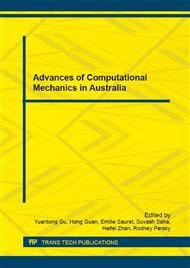p.421
p.428
p.434
p.440
p.446
p.452
p.458
p.464
p.470
Numerical Study of Basalt Fibre Cloth Strengthened Structural Insulated Panel under Windborne Debris Impact
Abstract:
Strong winds happen around the world every year and cause enormous damages and losses. Besides large wind pressure, impact from windborne debris on building envelope is a major source of structural damage in strong winds. The debris lifted and carried by wind impacting on building envelop may create openings on building envelope which increase internal pressure of the building, and lead to roof lifting and even total building collapse. Preventing impact damage to structural wall and roof is therefore critical in extreme wind conditions. On the other hand Structural Insulated Panel (SIP) with Oriented Strand Board (OSB) skins is popularly used in the building industry. Previous studies revealed that such SIP panels had weak impact resistant capacity and do not meet the design requirements to resist windborne debris impact specified in Australian Standard (AS/NZS1170.2:2011) for their applications in cyclonic regions. To increase the capacity of such SIP panels against windborne debris impact, basalt fibre cloth was used to strengthen the panel. Laboratory tests found that SIP strengthened with basalt fibre cloth was effective in increasing its impact-resistant capacity. This paper presents the development of a reliable numerical model to predict the impact responses of basalt fibre cloth strengthened SIP panel in LS-DYNA. The accuracy of the numerical model is verified by comparing the numerical and experimental results. The validated numerical model provides a reliable tool to predict basalt fibre cloth strengthened SIPs.
Info:
Periodical:
Pages:
446-451
Citation:
Online since:
July 2016
Authors:
Keywords:
Price:
Сopyright:
© 2016 Trans Tech Publications Ltd. All Rights Reserved
Share:
Citation:


